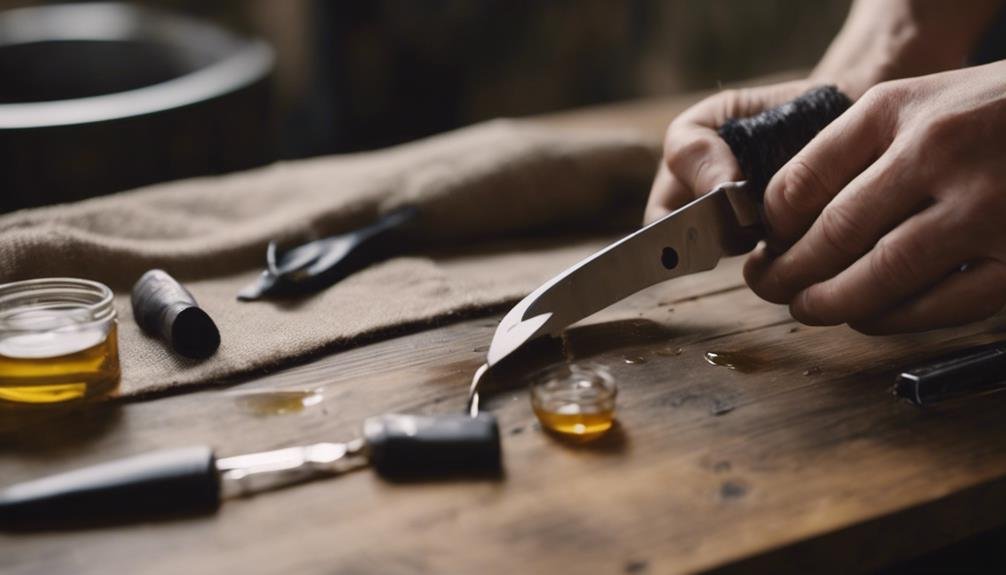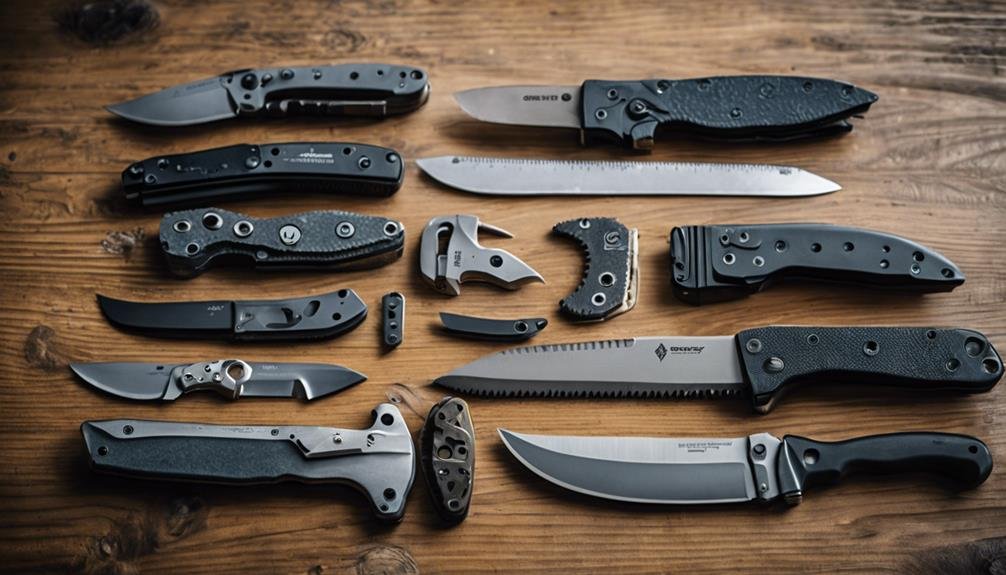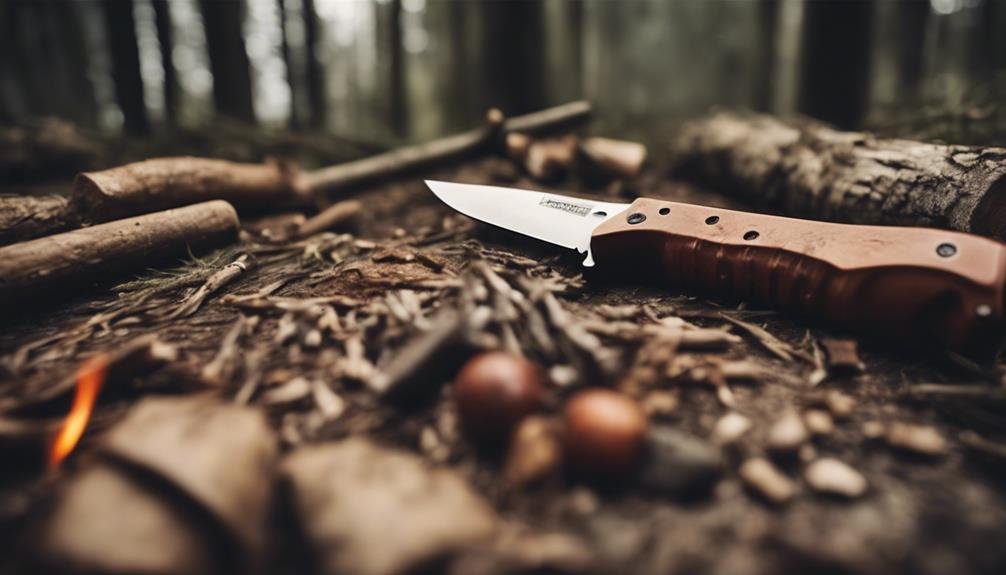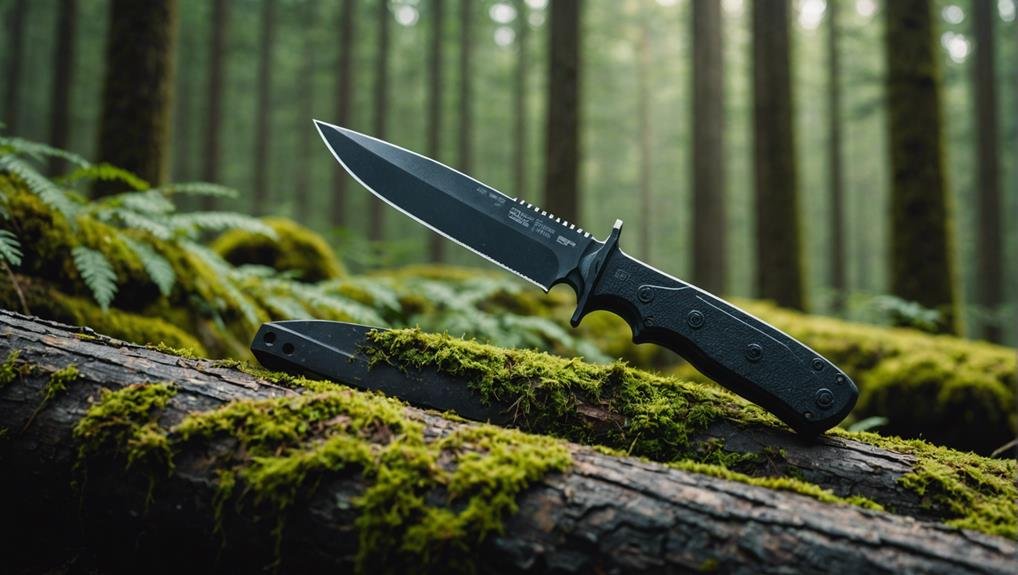When facing the great outdoors, having the right tool can make a significant difference in your ability to handle unexpected challenges. Imagine a tool designed to aid you in various situations, from building shelter to preparing food and even defending yourself if needed. A survival knife is more than just a blade; it’s a companion that can help you navigate through uncertainties with confidence and preparedness. But what sets a survival knife apart from the rest, and how can you guarantee you choose the perfect one for your adventures?
Key Takeaways
- Fixed blade knives are durable and reliable for heavy outdoor tasks.
- Consider blade steel quality, handle material, and brand reputation.
- Maintenance includes cleaning, drying, sharpening, and following the manufacturer’s instructions.
- Test ergonomics, grip, and safety features in real-life scenarios.
- Survival knives serve multiple functions like cutting, signaling, and fire-starting in emergencies.
Types of Survival Knives

When selecting a survival knife, it’s important to think about the type that best suits your specific needs and intended use.
One popular type to contemplate is the fixed blade knife. Known for their durability and strength, fixed blade survival knives are ideal for heavy-duty outdoor tasks. Whether you need to chop wood, baton through branches, or perform other demanding activities, a fixed blade knife is up to the challenge. Its solid construction and full-tang design make it reliable in survival situations where other types of knives might fail.
Additionally, the lack of moving parts in fixed blade knives reduces the risk of mechanical failure, ensuring that your tool will withstand harsh conditions. If you prioritize stability, strength, and simplicity in your survival gear, a fixed blade knife should be at the top of your list when contemplating which type of survival knife to invest in.
Key Features to Consider
When selecting the best type of survival knife for your needs, it’s important to focus on key features that will enhance your outdoor experience and preparedness. One vital aspect to take into account is the quality of the blade steel. The blade steel determines the knife’s durability, edge retention, and resistance to corrosion. High-quality blade steel, such as stainless steel or carbon steel, guarantees that your knife will withstand tough tasks and remain sharp in challenging conditions.
Additionally, when choosing a survival knife, pay attention to the handle material durability and the design of the sheath for safe storage and easy carry. Brands like Cold Steel, Gerber, and ESEE are known for offering reliable and versatile options suitable for various outdoor activities.
Some survival knives come equipped with extra features like fire starters, compasses, and serrated edges, providing multifunctional utility during emergencies. Select a survival knife that aligns with your intended outdoor pursuits, whether it’s camping, hiking, hunting, or general survival scenarios.
Maintenance and Care Tips

To keep your survival knife in peak condition, regularly cleaning it with mild soap and water is essential to remove dirt and debris. This practice helps maintain the blade’s integrity and ensures it remains free of contaminants that could cause corrosion.
After cleaning, make sure to thoroughly dry the blade before storing it in a dry environment to prevent rust and corrosion. Additionally, sharpening the blade regularly using a sharpening stone or tool will help maintain its cutting edge, ensuring peak performance when you need it most.
Following the manufacturer’s maintenance instructions is vital in prolonging the lifespan of your survival knife. Understanding the warranty coverage details before purchasing is also important, as different knives may have varying warranty terms that could impact your maintenance and care routines.
How to Choose the Right One
Choosing the right survival knife involves considering various factors such as blade shape, preferred styles, and steel variety. However, one important aspect that shouldn’t be overlooked is ergonomics. The knife should feel comfortable in your hand, allowing for extended use without causing fatigue or hot spots. When selecting a survival knife, think about how it will feel during various tasks, from cutting to carving.
Evaluating ergonomics involves more than just the handle shape; it also includes testing the knife in real-life scenarios. Make sure that the grip feels secure and that the knife remains easy to maneuver even in challenging conditions. Additionally, focus on corrosion resistance to guarantee longevity and durability.
Remember to look for handle materials like G10 or Micarta to improve grip and consider reliable lock mechanisms for safety. By prioritizing ergonomics alongside other factors like blade type and steel quality, you can find a survival knife that suits your needs perfectly.
Top Brands in the Market

Among the top brands in the market for survival knives is the Survivor brand, known for its classic designs and rugged fixed blade options. Survivor offers a wide range of high-quality knives, including the Fixed Blade Knife with Compass and the machete models SV-MHT004BK and SV-MHT008BK. These knives are equipped with accessories like 550 paracord and magnesium fire starters, enhancing their utility in survival situations.
With prices ranging from $5.28 to $104.29, Survivor provides affordable yet durable options such as the BOOT STEEL and WACKO WEDGE fixed blade knives. The brand caters to various preferences with models like HK-695 and machetes like SV-MHT009 and SV-MHT004BK.
Survivor knives are popular for their innovative designs, ensuring that you get value for your money with each purchase. Whether you need a reliable tool for camping, hiking, or emergency situations, Survivor brand survival knives have you covered.
Survival Knife Uses and Techniques
serve as indispensable tools in wilderness and emergency situations, offering versatile capabilities for tasks ranging from cutting and chopping to crafting tools and signaling for help. In addition to these fundamental uses, survival knives can also be utilized for starting fires. By using the spine of the blade against a fire starter or ferro rod, you can create sparks to ignite tinder and kindling, essential for warmth, cooking, and signaling rescuers.
When it comes to techniques, mastering the skill of safely starting fires with your survival knife is essential for survival in the wild. Other techniques include shelter building, food preparation, signaling for help, and crafting tools from natural materials. Remember, practicing these techniques before you find yourself in an emergency situation can make a significant difference in your ability to use a survival knife effectively.
Benefits of Owning a Survival Knife

Enhance your outdoor readiness and versatility with the multifunctional utility of a quality survival knife. A survival knife is a must-have tool for anyone venturing into the wilderness or preparing for emergencies.
The benefits of owning a survival knife are abundant. To begin with, a survival knife serves various purposes such as cutting, slicing, hunting, and self-defense, making it an indispensable tool in outdoor scenarios. The durable and robust blade of a survival knife, often made of high-quality steel, guarantees long-lasting performance even in challenging conditions.
Additionally, owning a survival knife enhances preparedness for wilderness adventures, camping trips, and survival situations, providing a sense of security and confidence. Many survival knives come equipped with extra features like fire starters, compasses, and serrated edges, further increasing their versatility and usefulness.
Whether you’re an outdoor enthusiast, hunter, camper, hiker, or prepper, a reliable survival knife is a valuable asset due to its functionality and utility.
Conclusion
To sum up, owning a survival knife is a wise investment for anyone who enjoys outdoor activities.
With the right knife, you can tackle various tasks with ease and confidence, whether it’s building a shelter, preparing food, or defending yourself in an emergency.
By choosing a high-quality knife, maintaining it properly, and honing your skills, you can enhance your outdoor readiness and stay prepared for whatever challenges come your way.

